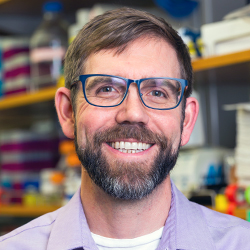Solving the Puzzle of Sustainable Energy
Keith Tyo is applying methods derived from computational synthetic biology to optimize clostridium
To succeed in the game Wordle, a player guesses which letters make up a five-letter word. Through the process of elimination, the player narrows down the possibilities until they find the solution to the puzzle.
It’s more complicated than that to make a sustainable and affordable fuel using clostridia (the plural of clostridium), bacteria that metabolize carbon. Yet it’s the essence of the work from Northwestern Engineering’s Keith Tyo.
“Leveraging clostridium could have several benefits,” Tyo said. “We’re working on how to realize those benefits.”
Tyo, associate professor of chemical and biological engineering at the McCormick School of Engineering, is using computational design algorithms with colleague Linda Broadbelt to rapidly assess thousands of potential biosynthetic pathway designs that could optimize clostridia’s production of biofuels. The two faculty members – and students in their respective labs – then work as one unit to narrow down which pathways have the best chance of succeeding.
Hence, the Wordle connection.
“I think I’m going to use that from now on,” Tyo quipped.

Working in collaboration with researchers from Northwestern Engineering, clean-energy startup LanzaTech, and Oak Ridge National Laboratory, the project could lead to methods to quickly design and prototype pathways in clostridia and eventually cheaper green fuels.
Figuring out how to get there is where Tyo comes in.
Why clostridia?
Clostridia is an ancient organism that grows on carbon monoxide, carbon dioxide, and hydrogen gas. Clostridia can thrive in unorthodox environments and can be used to make acetic acid or ethanol, the latter of which is a renewable fuel typically made from corn and other plant materials.
The challenge in making biofuels, however, is price.

Compared to growing corn and converting it into ethanol, the traditional methods of fuel production are cheap. Traditional fuels currently cost around $4 per gallon to produce. Producing biofuel from corn, however, includes farming and collection, which could lead to costs around $5 per gallon depending on the market – a cost that until recently was too high to be economically feasible.
LanzaTech has found a way to lessen the production toll by recognizing that carbon monoxide is a natural byproduct of steel production. Steel mills have no use for it, and LanzaTech realized that clostridia likes to grow on carbon monoxide.
The company then created a process to effectively use clostridia and the carbon monoxide together to produce ethanol. That works because ethanol is being produced from a chemical that costs next to nothing (carbon monoxide), rather than the cost of farming corn in traditional biofuels. Not only does the clostridia process provide cheap fuels, but it finds a use for emissions that could have been harmful.
“It’s very different than any other bioprocess that has come out of any other synthetic biology project,” Tyo said.
The Tyo Lab’s role
The current project aims to make an even better biofuel, butanol. To convert the carbon monoxide into butanol, enzymes spur chemical reactions. Working with Michael Jewett, Walter P. Murphy Professor of Chemical and Biological Engineering, the Tyo lab simulates what the enzymes are doing in cell-free reactions, which could prescribe changes to the production environment. That is a key because it dictates the kind of experiments needed out of thousands of possibilities. Those experiments are then carried out by LanzaTech.
Jewett’s lab provides data from the experiments to the Tyo lab, and Tyo’s team uses it to train the programs they’ve developed. Their goal: find the most efficient ways to make butanol, analyzing multiple choices to find the best options.

The production of other chemicals for industry is also necessary. Biology makes a wide range of chemicals already, but scientists are looking for places to get non-natural chemicals from sources other than petroleum. For this, Tyo is working with Broadbelt, Sarah Rebecca Roland Professor of Chemical and Biological Engineering, to predict chemical reactions from enzymes that should happen but haven’t been observed naturally. Doing that can lead to nature making chemicals it hasn’t before.
“There’s a lot of machine learning involved,” said Tyo, a member of the Center for Synthetic Biology. “We are able to design a set of chemical reactions to produce a chemical we’ve never seen produced by an enzyme.”
The Tyo and Broadbelt effort has produced an innovative tool, named Pickaxe. The standalone Python-based system encodes enzymatic reactions and predicts biosynthetic pathways. Pickaxe’s predecessor was written in C and C++ and lacked an intuitive user interface.
Pickaxe is open-source and uses the widely available and user-friendly chemistry software RDKit.
“It’s much more compatible with communities that are trying to use cheminformatics and bioinformatics tools more broadly,” Broadbelt said.
What’s next
Collaborations between Northwestern synthetic biologists and LanzaTech have been common. Other projects have included a parallel effort to efficiently produce other sustainable biofuels and chemicals.
Each project, Tyo estimated, takes about a year before the new non-natural chemical can be evaluated. That process isn’t always easy and requires mutual trust and understanding.
“There needs to be a strong collaboration between everybody involved,” Tyo said.
Looking forward, Tyo and Broadbelt are drawn to hybrid pathways. Working with chemists and other chemical engineers, they are exploring chemical catalysis, which takes molecules created by synthetic biology and functionalizes them further through reactions for which biology is less well suited.
If clostridia are doing the work to convert carbon monoxide to a fuel, then chemical catalysis could produce more diverse compounds.
“I think this is a perfect example of picking the right problem and then having the right tools and the right team to go after the solution,” Broadbelt said.